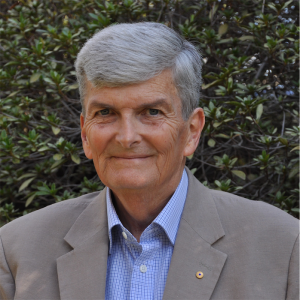
TO write a historical, non-fiction book where accuracy and first-hand accounts are paramount presents challenges, which get harder if the central character is no longer with us.
And even had he been around, he would never have collaborated with telling the story. In fact, he would have fought tooth and nail to stop it being published.
These hurdles faced NSW barrister-turned-politician-turned-author, Andrew Tink when he set out to chronicle the events that captured the world’s attention, nearly 50 years ago, centred around the frenetic environment we generally knew as the “Race to the Moon”.

NASA was pulling out all stops to claim bragging rights by being the first to put a man on the moon. Three high-tech facilities each contributed to that happening; Tidbinbilla, Orroral Valley and Honeysuckle Creek deep-space tracking stations near Canberra. It was the latter that piqued the author’s curiosity and resulted in the recently-released book “Honeysuckle Creek – the story of Tom Reid, a little dish and Neil Armstrong’s first step.” (UNSW Press).
Tom Reid was a Scotsman who graduated from Glasgow University with first-class honours in electrical engineering before migrating to Australia where he joined the Royal Australian Navy in 1952, serving as electrical officer for five years before taking a job at Woomera in SA with NASA’s Project Mercury as senior scientific officer.
He and his first wife, Betty, and their four children came to Canberra in 1964 where he became station director at Orroral Valley Space Tracking Station and later at Honeysuckle Creek. That station was destined to become invaluable by working collectively with similar stations in Spain and at Goldstone in the Californian desert to track the Apollo craft and provide data links for communication.
As director, Tom was often regarded as a prickly Glaswegian, not willing to suffer fools gladly. But it was this no-nonsense attitude that enabled him to form a team of talented technicians.
After a relatively short illness, Betty tragically died at the age of 36 leaving Tom to care for the children. Some years later, Andrew Tink began dating one of Tom’s daughters, Marg. It was during this time that Tink came to know Tom Reid and his second wife, Margaret, later to become ACT senator Margaret Reid, the first woman to be elected as Senate President.
“I tried to get him to talk about this on a few occasions – tried to get him to open up about what he’d done at Honeysuckle Creek, especially in relation to Apollo 11. But he always changed the subject,” says Tink.
“He absolutely hated, loathed, talking about himself. He was an extremely modest, private person and if he ever said anything about his work, he would always deflect to the team that he led.”
Tink remained in the dark about Reid’s work until after his death in 2010 and that’s when he decided to go ahead with the book.
While there had been many published reports about the role of Honeysuckle Creek in the Apollo 11 project – and the moon landing in particular on July 21, 1969 – the behind-the-scenes story of the station and Tom Reid’s role as director had never really been told.
The film “The Dish”, released in 2000, hit a raw nerve with Tink because it gave the impression that the Parkes tracking station in NSW was pivotal in getting that historical footage of Neil Armstrong landing on the moon.
“I sat there in the theatre watching the opening scenes and there was Sam Neill playing Cliff Buxton who was the so-called dish master of the Parkes dish,” says Tink.
“I sat there thinking ‘wrong place, wrong person’. And this just rankled with me.”
A couple of years later, Tink was at a function at the NSW parliament also attended by Senator Margaret Reid and daughter Marg.
“I said, Marg, what’s your father think of ‘The Dish’? She said he refused to watch it. He’s been told it contains major inaccuracies and he wants nothing to do with it,” Tink says.
The author acknowledges the work done by the Parkes tracking station, but he has long been keen to set the record straight regarding vision of the actual landing and that famous first step for mankind watched live by 600-million people around the world. And finally, the story of the unassuming Tom Reid is told.
Who can be trusted?
In a world of spin and confusion, there’s never been a more important time to support independent journalism in Canberra.
If you trust our work online and want to enforce the power of independent voices, I invite you to make a small contribution.
Every dollar of support is invested back into our journalism to help keep citynews.com.au strong and free.
Thank you,
Ian Meikle, editor



![For graphic designer Tracy Hall, street art is like any artwork, her canvas has been swapped out for fences and plywood, her medium changing from watercolours to spray paint.
A Canberra resident for 13 years, Tracy has been a street and mural artist for the past five.
Her first exploration into grand-scale painting was at the Point Hut toilets in Banks five years ago. “They had just finished doing up the playground area for all the little kids and the words [of graffiti] that were coming up weren’t family friendly,” she says.
“So I ended up drawing this design and I got approval for the artwork.”
Many of Tracy’s time-consuming artworks are free, with thousands of her own dollars put into paint.
@traceofcolourdesigns
To read all about Tracy's fabulous street art, visit our website at citynews.com.au or tap the link in our bio! 🎨🖌
#canberranews #citynews #localstories #canberrastories #Citynews #localnews #canberra #incrediblewomen #journalism #canberracitynews #storiesthatmatter #canberralocals #artist #streetart #streetartist #StreetArtMagic](https://scontent.cdninstagram.com/v/t39.30808-6/490887207_1225841146218103_6160376948971514278_n.jpg?stp=dst-jpg_e35_tt6&_nc_cat=106&ccb=1-7&_nc_sid=18de74&_nc_ohc=yse5ujF1BOUQ7kNvwE8vMJJ&_nc_oc=AdmACWW3pCwuhoAJjTJgeYL0PrOjZetex1flAsV7seJ8OPT1_w_DCdBrY998OXsAdFw&_nc_zt=23&_nc_ht=scontent.cdninstagram.com&edm=ANo9K5cEAAAA&_nc_gid=M3Eat5CavCFLyQKem8wl7A&oh=00_AfEelLohW-0BM38EPlPqLO_ehfn2HbeGBZ7_42rmOJ7w8w&oe=68079794)




Leave a Reply